The modern business operator (that’s you!) must decode an ever-shifting landscape of digital alphabet soup. There’s a parade of acronyms, each one heralded “absolutely necessary” for success. They can be difficult to keep straight and nearly impossible to examine as worthy tools for your business. So, allow us to unscramble the jumble a bit, beginning with the perfect bite: POS.
What is POS?
POS stands for “point of sale,” defined as: a place where something is sold to the public, where someone pays for something.
You can think of this as a cash register. Well, you might be thinking to yourself, I suppose I’ve got POS covered. Not quite! When you see POS, it probably refers to a POS system rather than an old-school cash register. As technology has evolved, POS systems followed suit in order to give operators more bang for their buck.
A Bit of History
The first cash register, like many of the best breakthroughs, was an invention of necessity. The year was 1879 and saloon owner, James Ritty, had just discovered some of his employees were skimming off the profits. He devised a machine that could record the number of orders received as well as the totals of those orders, which he dubbed “Ritty’s Incorruptible Cashier.”
Though your employees surely aren’t the opportunists of Ritty’s time, the sticky fingers on his floor began a long tradition of technology supplementing that hard to swallow truth: that we cannot be everywhere at once. Fast forward more than a century and, since we’ve yet to craft a cloning machine, the power of POS systems still prevail.
Traditional vs. Cloud-Based POS Systems
Today’s POS, true a partner as the “incorruptible” first, serve to open a line of communication between you, your business, your consumers, and everything between them. They come in two forms depending on your needs and budget: traditional and cloud-based.
Traditional POS systems store data at the site where the sale happens and require you be physically present to access that data. This means that it usually can only be accessed using a single device, but that the system will be less expensive and require fewer updates.
Cloud-based POS systems, on the other hand, are more easily customizable and allow you to access your information on the go. These will require more updates and will probably be a bit more expensive to set up.
Regardless which form you choose, POS systems work to increase your efficiency, profits, and insight.
Hardware vs. Software
This process requires two components: hardware and software.
Hardware most closely harkens back to the basic definition of POS and Ritty’s time, though it certainly looks very different. These are your physical machines—your cash registers, tablets, card readers, and beyond. For in-person providers, hardware is as much a necessity as a wonderfully greasy burger at a dive bar or a deep dish pizza in Chicago, and equally expected.
Software is widely varied, depending on individual company needs and desires. This is the programming that turns your hardware from single function into a machine capable of wearing many hats. Various softwares can also combine to help you get customized results. While no two POS software look the same, the goal across the board is to turn the numbers floating around in your system to usable information.
Amplifying POS Data
There are many benefits to adding a POS system to your operation, and that number is multiplied exponentially once you begin adding additional programs like Craftable. Some possible advantages include:
- Inventory Management
- Invoicing
- Customer Management
- Staff Management
- Reporting & Analytics
- & More!
Listing everything out may make you feel like we are back in the thick of the alphabet soup, but it’s helpful to think back to Ritty. POS software simply creates channels to access and understand information. That information helps you run a better business by letting you run that business better. While you cannot be everywhere at once, POS systems make you feel like you are.
If you’re ready to take the next step, check out some of the POS providers we integrate with here.




.png)